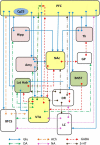Repurposing Ketamine in Depression and Related Disorders: Can This Enigmatic Drug Achieve Success?
- PMID: 33994933
- PMCID: PMC8120160
- DOI: 10.3389/fnins.2021.657714
Repurposing Ketamine in Depression and Related Disorders: Can This Enigmatic Drug Achieve Success?
Abstract
Repurposing ketamine in the therapy of depression could well represent a breakthrough in understanding the etiology of depression. Ketamine was originally used as an anesthetic drug and later its use was extended to other therapeutic applications such as analgesia and the treatment of addiction. At the same time, the abuse of ketamine as a recreational drug has generated a concern for its psychotropic and potential long-term effects; nevertheless, its use as a fast acting antidepressant in treatment-resistant patients has boosted the interest in the mechanism of action both in psychiatry and in the wider area of neuroscience. This article provides a comprehensive overview of the actions of ketamine and intends to cover: (i) the evaluation of its clinical use in the treatment of depression and suicidal behavior; (ii) the potential use of ketamine in pediatrics; (iii) a description of its mechanism of action; (iv) the involvement of specific brain areas in producing antidepressant effects; (v) the potential interaction of ketamine with the hypothalamic-pituitary-adrenal axis; (vi) the effect of ketamine on neuronal transmission in the bed nucleus of stria terminalis and on its output; (vii) the evaluation of any gender-dependent effects of ketamine; (viii) the interaction of ketamine with the inflammatory processes involved in depression; (ix) the evaluation of the effects observed with single or repeated administration; (x) a description of any adverse or cognitive effects and its abuse potential. Finally, this review attempts to assess whether ketamine's use in depression can improve our knowledge of the etiopathology of depression and whether its therapeutic effect can be considered an actual cure for depression rather than a therapy merely aimed to control the symptoms of depression.
Keywords: anxiety; depression; drug repositioning; esketamine; glutamate; suicide.
Copyright © 2021 Carboni, Carta, Carboni and Novelli.
Conflict of interest statement
The authors declare that the research was conducted in the absence of any commercial or financial relationships that could be construed as a potential conflict of interest.
Figures



Similar articles
-
A review of ketamine in affective disorders: current evidence of clinical efficacy, limitations of use and pre-clinical evidence on proposed mechanisms of action.J Affect Disord. 2014 Mar;156:24-35. doi: 10.1016/j.jad.2013.11.014. Epub 2013 Dec 10. J Affect Disord. 2014. PMID: 24388038 Review.
-
What is the mechanism of Ketamine's rapid-onset antidepressant effect? A concise overview of the surprisingly large number of possibilities.J Clin Pharm Ther. 2017 Apr;42(2):147-154. doi: 10.1111/jcpt.12497. Epub 2017 Jan 22. J Clin Pharm Ther. 2017. PMID: 28111761 Review.
-
[Ketamine's antidepressant effect: literature review on clinical use].Encephale. 2014 Feb;40(1):15-23. doi: 10.1016/j.encep.2013.09.001. Epub 2014 Jan 14. Encephale. 2014. PMID: 24434008 Review. French.
-
Sex differences in sub-anesthetic ketamine's antidepressant effects and abuse liability.Curr Opin Behav Sci. 2018 Oct;23:36-41. doi: 10.1016/j.cobeha.2018.02.001. Epub 2018 Mar 2. Curr Opin Behav Sci. 2018. PMID: 30038955 Free PMC article.
-
[Pharmacology of ketamine and esketamine as rapid-acting antidepressants].Psychiatriki. 2021 Dec;32(Supplement I):55-63. doi: 10.22365/jpsych.2021.050. Psychiatriki. 2021. PMID: 34990380 Review. Greek, Modern.
Cited by
-
Region-Specific Enhancement of c-fos Expression by Combined Treatment With NMDA Receptor Agonists and Antagonists With Antidepressant Potential.Int J Neuropsychopharmacol. 2022 Nov 17;25(11):946-950. doi: 10.1093/ijnp/pyac051. Int J Neuropsychopharmacol. 2022. PMID: 35974297 Free PMC article.
-
Review: The use of functional magnetic resonance imaging (fMRI) in clinical trials and experimental research studies for depression.Front Neuroimaging. 2023 Jun 27;2:1110258. doi: 10.3389/fnimg.2023.1110258. eCollection 2023. Front Neuroimaging. 2023. PMID: 37554642 Free PMC article. Review.
-
The Psychedelic Future of Post-Traumatic Stress Disorder Treatment.Curr Neuropharmacol. 2024;22(4):636-735. doi: 10.2174/1570159X22666231027111147. Curr Neuropharmacol. 2024. PMID: 38284341 Free PMC article. Review.
-
Where ketamine and dopamine collide.Elife. 2021 Jun 17;10:e70148. doi: 10.7554/eLife.70148. Elife. 2021. PMID: 34137373 Free PMC article.
-
Ketamine ameliorates activity-based anorexia of adolescent female mice through changes in GluN2B-containing NMDA receptors at postsynaptic cytoplasmic locations of pyramidal neurons and interneurons of medial prefrontal cortex.Brain Struct Funct. 2024 Mar;229(2):323-348. doi: 10.1007/s00429-023-02740-w. Epub 2024 Jan 3. Brain Struct Funct. 2024. PMID: 38170266
References
Publication types
LinkOut - more resources
Full Text Sources
Other Literature Sources

